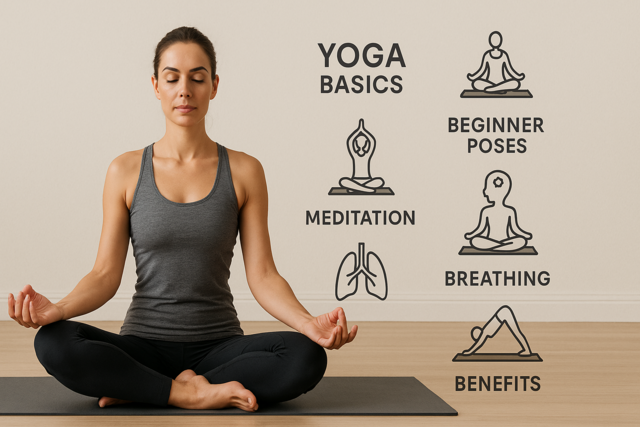Ayurveda and Relaxation
-
5000 Years of Experience
-
Terminology
-
The Doshas in General: Vata, Pitta, Kapha
-
Your Dosha: Vata, Pitta, Kapha
-
Which One Are You?
While Yoga is a commonly accepted form of complementary medicine in the Western world, a great many people are not familiar with Yoga's sister, Ayurveda. As you have already learned about mindfulness, when you pay close attention to your body, it has answers to many questions you have about it. Ayurveda has an extremely long history of being very in tune with the very nature of the body. As such, Ayurveda is an excellent way to learn about your basic body nature and how to keep it in balance.
Ayurveda has a history going back at least 5000 years and is considered to be the most ancient and traditional science of medicine dealing with basic principles of a natural way of living a full and healthy and balanced life.
Ayurveda, being many thousands of years old, has influenced many other healing systems from around the world. It was long established before the births of Buddha and of Christ, and there is evidence of Ayurvedic teachings in the Bible, most specifically the anointing of the head and feet with oil.
There are many branches to Ayurveda, because it covers all aspects of health and healing. The basis of Ayurveda is that all sickness and stress is caused by the food we eat, and that it either is not the right food, or that we are not digesting it properly. The emphasis in this article will be on nutritional and lifestyle suggestions that you can easily incorporate into your life.
Let's break it down into its root words for easier understanding.
Ayur means "life."
Veda means "wisdom."
Put together, Ayurveda translates to the wisdom of life. Both Yoga and Ayurveda are considered to be sister sciences, coming from Vedic traditions; they were used for thousands of years to complement one another, or were used in harmony with one another. When these two traditions came to the Western world, they traveled separately, which explains why you may be aware of Yoga, but not Ayurveda.
Consider some of the suggestions in this article, and see if you gain a greater "wisdom of life" for yourself by evaluating your basic nature and what it might mean in the Ayurvedic tradition.
When you practice the "wisdom of life" you live better, you eat better, and your health is better.
5000 Years of Experience
Ayurveda is the traditional healing system in India, in traditions that go back even further than those of Chinese medicine. In fact, there is evidence that Chinese medicine was influenced by Ayurveda. It is considered to be the oldest healing system in the world. Ayurveda encompasses all aspects of one's life, and to try to teach you everything there is to do with Ayurveda in a single article would be like guaranteeing you a medical degree in a single lesson. This is not possible.
However, what is possible is to help you to understand how Ayurveda can be an alternative approach to your problems when your life is out of balance. It is an excellent adjunct to Western medicine because Ayurveda is many thousands of years old and has had a definite impact on other medical systems or healing systems throughout the world. You can easily incorporate aspects of Ayurveda into your lifestyle as a complement to your understanding of Western approaches to lifestyle balance.
As with Western medicine, there are many branches of Ayurveda. What you will learn in this article is how to incorporate Ayurvedic principles into your life, and with this understanding to promote relaxation and improve your overall health through balance.
In Ayurveda, everything must be in balance in order to live a long and healthy life. This means that in order to be relaxed, your life must be in balance. Consider some of the following information and see if there might be Ayurvedic ways that your life might be out of balance. Then, by incorporating small changes, you will see how you might impact your life, bring it into better balance, and experience greater levels of relaxation as a result.
Terminology
You've already learned that Ayurveda means the wisdom of life. Before we go any further, let's learn the meaning of several words that may be new to you.
Dosha means "nature" or "characteristics" that define your nature. In the Ayurvedic tradition, there are three main doshas:
-
Vata which represents ether (or space) and wind.
-
Pitta represents fire and earth.
-
Kapha represents water and earth.
Everything is made up in some way of these three doshas: living beings, foods, seasons, etc. When we say that vata represents space and wind, it doesn't mean that we're talking about the physical substance, but more the qualities that are embodied in those substances.
For example, the qualities of space and wind, are lightness, movement, coolness, dryness, and mobility. All these together form the vata dosha.
The qualities of fire are heat or illumination. The pitta dosha is almost all fire with a little bit of water. Everything about the pitta dosha has to do with the qualities of fire, penetrating, illuminating, and hot.
A quality of water is fluidity, and a quality of earth is solidity. Together these form the kapha dosha, which is responsible for all the binding energy in the body and mind, lubricating and protecting.
The basic premise of Ayurvedic medicine is that all disease is caused by our digestive system, either our body is not digesting food properly, or we are following an improper diet for our nature or dosha.
Once you learn which is the main characteristic of your nature, or your dosha, you will have a good idea of the types of foods you should be eating for better balance in your life. By understanding our nature better we will learn how to keep our dosha in balance. This is much, much more than just a list of foods to eat; it is more complex, because even foods carry vata, pitta, and kapha in them.
The Dosha in General: Vata, Pitta, Kapha
Each dosha is present at every single dimension of the human body, even at a cellular level.
Vata Dosha:
-
Body Level: Vata, being the energy of movement, is responsible at the body level for our voluntary and involuntary movements, such as our heart beating, our GI tract, the involuntary blinking of the eye.
-
Psychological Level: Vata is responsible for the force of movement of our mind. Our mind is the fastest entity of all. It can jump from a thought close by, to the ends of the galaxy in a split second. We jump from thought to thought, from feeling to feeling.
Pitta Dosha:
-
Body Level: Pitta is the energy of transformation, of heat and digestion. Pitta is responsible for our body's ability to keep a constant temperature of 98.6; it is responsible for thermogenesis -- or the creation of heat, for the digestive enzymes that chemically heat up the food that we eat and digest.
-
Psychological Level: Pitta represents the mind's capacity to digest the information and perceptions we take in from the outside world, assimilating them into some kind of useful action, or enhancing our understanding of something. We frequently say that someone who is smart is bright; bright is a quality of fire. Brilliance.
Kapha Dosha:
-
Body Level: Kapha respresents the body's ability to create more body mass, more cellular mass. For example an infant weighs a mere 6 to 8 pounds at birth, on average; but as the child grows, the weight it puts on is a manifestation of kapha, which is a very strong force in children. Unfortunately, kapha can continue to be a strong force as we age and continue to put on weight we don't need as we become more static and deliberate in our movements. Kapha is also responsible for the lubrication of our joints, our lung cells keeping them moist and lubricated.
-
Psychological Level: Kapha manifests itself as our memory, or ability to hold onto, or to bind, information that we see or hear. It also represents our ability to have resilience or stamina in the face of stress.
It's time to identify your individual dosha. Remember, this is the briefest introduction to Ayurveda, and to understand your dosha at a much greater level, you might wish to visit an Ayurvedic-trained physician to more accurately identify your nature. They will take you through an exhaustive list of questions to establish your basic dosha nature and which doshas may have been affected that threw you out of balance.
However, understanding even to a small degree, your nature, will help you on the road to greater balance in your life.
In Ayurvedic medicine, when you were most balanced in your life is when you were the healthiest. Think back to a time when you felt very healthy, very balanced. Perhaps it was when you were 25 and were at the peak of your physical fitness. That will help you to establish your true dosha. By comparing that to your current state, you will be able to see in what ways you many have become imbalanced and take steps to correct this. Only by comparing where you are now with how you were in the past, both at your healthiest and at your sickest, can you establish your true dosha.
Read through the next three sections and see which dosha most closely represents you when you were at your healthiest and happiest in your life. Remember, everyone has all three doshas, but most people will more closely fit one dosha over another.
(Note: many of you will recognize the Western classification of the physical presentation of a body as an ectomorph, endomorph, and mesomorph. What you will also note is how much more detail the Ayurvedic tradition provides to the physical manifestation of basic body shapes.)
Vata: The vata is usually thin, narrow, either tall or short. They do not gain weight easily, and lose it even more easily and their tendons are prominent. They are restless by nature, and generally keep very busy and active. Their skin is darker, dry, and cold. They have an average amount of hair, dry, thin, usually dark. Their eyes are small, narrow, or sunken and are either dark brown or gray. They have small or large, but irregular, teeth with receding gums. They move quickly. They have low endurance or stamina, and are not very strong. They prefer warmth and feel cold before any other type of dosha. Their stools tend toward constipation. They tend to live an erratic lifestyle, their sleep is light, interrupted, and fitful. Emotionally they are anxious, insecure, and suffer from a lot of fears. They have great creative ideas and have an excellent memory for recent events. They react to stress by becoming easily excited, susceptible to mood changes, and talk very fast.
When a vata is out of balance, it is best to counterbalance them. For the cold and airy vata person rich warm foods help to warm them up. They should to go a warm and humid environment for their vacations because this will soothe the cold vata personality. If they choose to go on a cold mountain hike, it would be best if there is a nice hot stew waiting for them and even a steam bath at the end. Because a vata is so erratic and changeable in their nature, they need more structure and regularity in their routine, even though they will resist this with all their might. Because they expend so much energy during the day, they need extra sleep in order to recuperate.
Pitta: The pitta is medium build, height, and body frame. They tend to sweat profusely, even when there is just a little bit of heat. Their skin is soft and warm, fair to pink or red, and are often freckled. Their hair is fine, soft, red or fair, tending toward thinness and early graying. Their eyes are of average size and are blue, gray, or hazel, very intense. Their teeth are yellowish with gums that tend to bleed. They move about at a moderate pace with good strength and endurance. They prefer cool weather. Their stools tend to be looser. They are always busy and tend to accomplish a lot. Their sleep is short, but sound. Emotionally they are fiery, angry, judgmental. Their mind is sharp and logical, very precise with a generally good memory. They respond to stress with temper. They tend to be more intellectual than creative and their moods change slowly. They speak clearly and precisely.
Because there is so much internal heat in a pitta, anything with external heat will aggravate them. They hate hot weather, tend to sweat easily, and even the slightest bit of heat can irritate them. Even hot food will throw them off. They may like hot and spicy foods, but it will help them to go out of balance; instead they should gravitate toward cooler foods like fruits and salads. Too much internal heat easily aggravates the pitta, and this can even be from too much alcohol. All the good qualities of the pitta, their tendency to be excellent leaders, and having a good and loyal following can manifest as competition and jealousy when out of balance. To balance the pitta, they need more coolness in both their environment and in their foods.
Kapha: The kapha can be either tall or short, but very sturdily built. Not necessarily fat, but sturdy, they are solidly built and gain weight easily. They sweat moderately and their skin is most and cool, tending toward oiliness, and is pale and white. They usually have thick lustrous hair, generally brown or black. Their eyes are large and prominent, either brown or blue. They have large white teeth and strong gums. They move at a slow and steady pace and have excellent strength and endurance. They have an aversion to cool and damp environments. They have plentiful stools. They are steady workers, and often skip meals. Their sleep is deep and they like to sleep a great deal. They can be greedy and possessive in terms of their emotions. Their mental activity is calm, steady, and stable, and they have excellent long-term memory. They are not easily irritated by stressors, and are very caring in their work environment. They demonstrate steady moods and tend to speak in a deep voice with a steady manner.
For example, if you were a pitta at the prime of your life, and you are more of a kapha now, you could be said to be suffering from kapha imbalance and need to take the appropriate steps to return you to your true pitta nature.
The basis of Ayurvedic treatment is through the diet and other dosha-balancing interventions. Think about the qualities of the foods you eat in terms of which dosha is most predominant for you. You can balance your doshas with food, where you live in terms of your environment, even the clothes you wear and what colors you surround yourself with.
Everyone has all three doshas, but everyone has a predominance of one over the others. All doshas have positive qualities when they are in balance and negative qualities when they are out of balance.
Doshas are present in time of day and what season it is. This helps to know when it is best to do certain activities and when it is best to avoid certain activities. For more information about Ayurveda, seek out books, classes, or even a consultation with an Ayurvedic physician. By learning more about your nature, you have a better chance of establishing a life balance that has been missing for quite some time.
Learning about the nature of your body keeps you in tune with its needs and what it is lacking. A better balance leads to greater health and contentment. In order to enhance relaxation in your life, being balanced and in tune with your body is essential. By establishing the dosha or nature of your body, you can then incorporate both foods and activities that more accurately support your nature, rather than falling back on foods and behaviors out of habit.

























